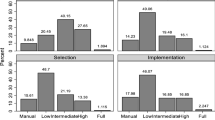Abstract
The rules of evidence codify the legal system’s evolved wisdom about fairness and validity. Especially on point are the rules pertaining to relevance (Federal Rules of Evidence (FRE) 401), expert testimony (FRE 702), questioning witnesses (FRE 611), prejudice (FRE 403), hearsay (FRE 802), and character evidence (FRE 404). This paper assays to improve our reports and align them with the legal culture, regardless of whether this is needed to make our reports admissible, and to take advantage of what jurisprudence knows about weighing and presenting evidence. The paper reviews the most salient courtroom evidentiary rules, along with their associated courtroom objections, and discusses their implications for report writing. Understanding our legal system’s treatment of evidence can improve our own.
Similar content being viewed by others
References
American Bar Association. (2014). Trial objections list. Retrieved from American Bar Association website: http://www.americanbar.org/content/dam/aba/migrated/domviol/docs/Handout_1_Trial_Objections_List.authcheckdam.pdf
American Psychiatric Association. (2000). Diagnostic and statistical manual of mental disorders (4th ed., Text Revision). Washington, D.C.: Author.
American Psychological Association. (2010). Publication manual of the American Psychological Association. Washington, D.C.: Author.
Federal Rules of Evidence. (2013). 28 U.S.C. app. §§ 101-1103.
Fulero, S. M., & Wrightsman, L. S. (2009). Forensic psychology. Belmont, CA: Wadsworth.
Grice, J. W. (2004). Bridging the idiographic-nomothetic divide in ratings of self and others on the Big Five. Journal of Personality, 72, 203–242.
Grisso, T. (2010). Guidance for improving forensic reports: a review of common errors. Open Access Journal of Forensic Psychology, 2, 102–115.
Hathaway, S. R., & McKinley, J. C. (1989). Minnesota Multiphasic Personality Inventory-2 (MMPI-2): manual for administration and scoring. Minneapolis: University of Minnesota Press.
Karson, M. (2005a). Ten things I learned about report writing in law school (and the eighth grade). The Clinical Psychologist, 58(3), 4–11.
Karson, M. (2005b). Over-interpretation of the Rorschach and the MMPI-2 when standard error is ignored. Scientific Review of Mental Health Practice, 3(2), 25–29.
Karson, M. (2006a). Diagnostic validity. In N. Salkind (Ed.), Encyclopedia of measurement and statistics. Thousand Oaks, CA: Sage.
Karson, M. (2006b). Using early memories in psychotherapy: roadmaps to presenting problems and treatment impasses. Lanham, MD: Aronson.
Karson, M., & Nadkarni, L. (2013). Principles of forensic report writing. Washington, D.C.: American Psychological Association.
King, S. (2010). On writing: a memoir of the craft. New York: Scribner.
Loftus, E. (1979). Eyewitness testimony. Cambridge, MA: Harvard University Press.
Loftus, E., & Ketcham, K. (1994). The myth of repressed memory: false memories and allegations of sexual abuse. New York: St. Martin’s Griffin.
Mauet, T. A. (1996). Trial techniques (4th ed.). New York: Aspen.
Mayman, M. (1959). Style, focus, language and content of an ideal psychological test report. Journal of Projective Techniques, 23, 453–458. doi:10.1080/08853126.1959.10380956
Munley, P. (2002). Comparability of MMPI-2 scales and profiles over time. Journal of Personality Assessment, 78, 145–160.
Slobogin, C. (1989). The “ultimate issue” issue. Behavioral Sciences and the Law, 7, 259–266.
Author information
Authors and Affiliations
Corresponding author
Rights and permissions
About this article
Cite this article
Karson, M. What Can the Rules of Evidence Teach Us About Writing Forensic Reports?. Psychol. Inj. and Law 8, 1–10 (2015). https://doi.org/10.1007/s12207-015-9213-7
Received:
Accepted:
Published:
Issue Date:
DOI: https://doi.org/10.1007/s12207-015-9213-7




